 |
| January 08, 2013 | Volume 09 Issue 01 |
Designfax weekly eMagazine
Archives
Partners
Manufacturing Center
Product Spotlight
Modern Applications News
Metalworking Ideas For
Today's Job Shops
Tooling and Production
Strategies for large
metalworking plants
Racing bike designer uses 3D CAD software to create lighter, more precise parts
Raimondo Berger, a German designer, manufacturing expert, and lover of sport motorcycles, designs and builds forward controls, triple trees, and other precision parts for sport motorcycles of various brands. SpaceClaim Engineer software gives him a 3D tool to rapidly give shape to ideas and develop them to the production stage with minimal inconvenience. With SpaceClaim as his tool, Berger is daring even to reconstruct the legendary Honda CB 900 Bol d'Or Super Sport from 1979.
"I have the enormous advantage of bringing my love of motorcycles to the production technology. I design parts that I know can be produced reasonably and quickly," says Berger. In the 1980s, Berger produced his designed parts on the milling machine himself and sold them to his fellow motorcyclists. So in the 1990s he and a colleague founded the company RaiRoTec, and they successfully designed and sold parts for sport motorbikes. These parts realize the full potential for improvement of standard products and improve them with respect to function, weight, and sporty look.
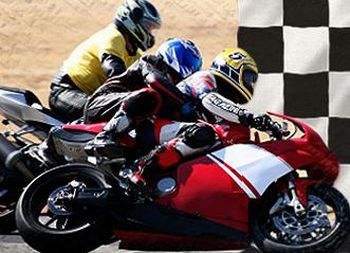
RT-CNC in Germany develops parts that are light, stable, and precise for various brands of sports bikes.
Following the acquisition of RaiRoTec by another company in 2009, Berger remained associated with the company as chief engineer, but he had already founded RT-CNC, his own company for construction services, many years before. The main focus here is on continuing with what Berger does best: forward controls, triple trees, and other precision parts for motorcycles. The exceptional "technical" appearance of a Berger forward control is characterized by its elaborate and sophisticated design and high-quality manufacturing. Although the difference in weight compared to the mass market is usually only slight, riders equipped with a Berger footrest enjoy several improved features: individual adjustment from comfort to sporty, shorter, more precise shift travel, fine-tuned braking, and more grip on the sole of the foot when it rains -- all factors that are of high importance when riding a sport motorcycle.
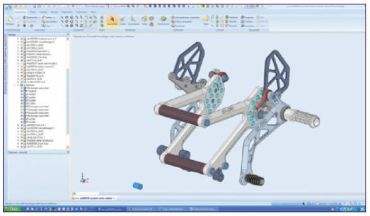
Footrests designed by Raimondo Berger for an Aprilia motorcycle in SpaceClaim.
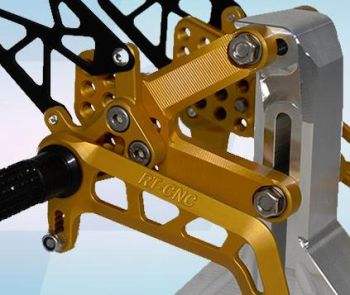
3D design without a manual
As Berger himself says, he thought about developing a sophisticated product such as footrests in 3D for many years, but was deterred by the high cost. A colleague from production who is always on the lookout for inexpensive 3D systems that can be used without a manual introduced Berger to SpaceClaim. Since Berger liked the system's look and feel and the price was very attractive for a 3D system with extensive functionality, Berger then decided to attend a one-day training at German SpaceClaim reseller Lino in the summer of 2011.
"I was persuaded by the fact that I could open my extensive and sometimes old DXF files easily, put them together, and build a 3D model in SpaceClaim," says Berger. He was also determined to put the performance and skills of the Lino staff to the test and proposed working with one of his most complex DXF drawings. However, loading, editing, and design of the 3D model went perfectly with the support of Lino professionals. "Everything else I've done since then with SpaceClaim I've accomplished simply by doing it because the user interface is so intuitive."
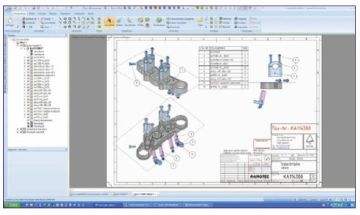
Triple tree set in a 3D drawing and parts list.
Above all, it is the directness and immediacy of SpaceClaim that convinced Berger, who has worked with many 3D CAD systems, that he had found the right tool for the job. "What I can handle in SpaceClaim in five steps would take me ten steps in a traditional CAD system," he says. The first 3D part Berger designed in SpaceClaim was based on an existing DXF file. This part with complex geometry stiffens the motorcycle front end, saves weight, provides a more comfortable seating position, and can be mounted within 30 minutes. "It is simply impossible to explain the structure of the triple clamp just based on a DXF file," says Berger.
Kit for design parts
The designer and entrepreneur then built a 3D-parts kit from a wide variety of parts. Now, if he wants to create a new forward control for example, he first works out the basic design in connection with the bike frame (the mounting points vary constantly from manufacturer to manufacturer and from model to model), then pulls the other components from his kit and builds up the final part. "If you build a model from external data in another 3D system, it is only a dumb model. In SpaceClaim you instantly have a real model that you can continue working on directly, either on the constructive side or in the production pipeline." The production partner then creates the 5-axis programming from the 3D STEP and IGES data supplied by Berger. Based on his many years of manufacturing experience, Berger drafts his designer pieces so that they can be produced with a minimum of fixtures and clamping.
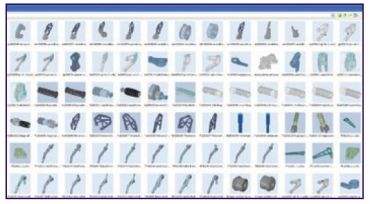
Footrest kit for rapid 3D design.
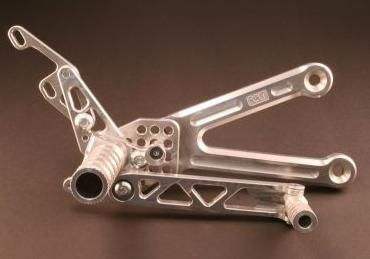
Design features proven in day-to-day design work
For the design of the complicated geometry of the footrest, Berger appreciates how he can easily and intuitively execute design changes like the addition of a brake cylinder or various changes in form such as slants, angles, and the changing line of a chamfer along a support, and thus "cast" his ideas in a solid form. Put simply, SpaceClaim supports him in the realization process, instead of obstructing him. His response to the four command buttons, "Pull, Move, Fill, Combine": "Absolutely great."
He uses SpaceClaim very much as a sketch tool to note ideas and concepts. "Before I sketch what I'm thinking with paper and pencil, I prefer to build a model in SpaceClaim, and then my business partner understands what I mean. This 3D work costs me almost no time." The engineer and designer also likes the ability to rapidly place logos and lettering on the 3D model. Next, Berger plans to develop motorcycle tanks and manufacture them in aluminum. The benefits include less weight and an organic shape with an attractive, memorable appearance. In the design of free-form surfaces, the direct interface between SpaceClaim and the 3D free-form modeling tool Rhino is extremely useful, allowing him to open Rhino files directly in SpaceClaim, edit, and then re-send them in their native format to Rhino. In addition, SpaceClaim includes free-form surface features as well.
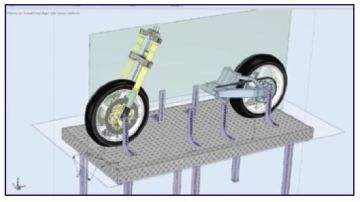
Project 2012/13: reconstruction of the sport bike Honda CB 900 Bol d'Or from 1979.
Reconstruction of the Honda CB 900 Bol d'Or Super Sport
In 2013, Berger will present his most ambitious project at at a trade show: the reconstruction of the sport motorcycle Honda CB 900 Bol d'Or Super Sport from 1979. The Bol d'Or (French for "golden bowl") is in fact one of the most famous 24-hour motorcycle races. Berger will reconstruct the bike completely in 3D using SpaceClaim and then have it manufactured by contract fabricators. He has already created a modified frame with modern geometry and additional components to stiffen it, the fork, wheels, chain, sprockets, and more. In his next step, he will recreate the installation space of the engine with the screw points on the frame. The goal is to completely map the bike in 3D -- of course with its own crown and footrest controls. Berger probably wouldn't tackle this project with another 3D system: "This is the first 3D system with which I can work professionally and with minimum inconvenience. Its greatest advantage is its ease of use."
Want more information? Click below.
Published January 2013
Rate this article
View our terms of use and privacy policy
